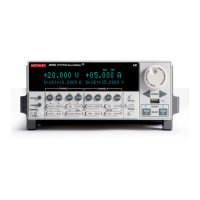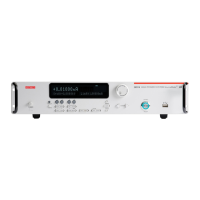7: TSP command reference Series 2600B System SourceMeter® Instrument
7-250 2600BS-901-01 Rev. B / May 2013
smuX.trigger.source.logY()
This function configures an exponential (geometric) source sweep.
Type TSP-Link accessible
Affected by Where saved Default value
Usage
smuX.trigger.source.logY(startValue, endValue, points, asymptote)
Source-measure unit (SMU) channel (for example, smua.trigger.source.logv(1,
10, 11, 0) applies to SMU channel A)
SMU source function (v = voltage, i = current)
Source value of the first point
Source value of the last point
The number of points used to calculate the step size
The asymptotic offset value
Details
This function configures the source action to be a geometric source sweep in a subsequent sweep. During the
sweep, the source generates a geometric series of ascending or descending voltage or current changes called
steps. Each step is larger or smaller than the previous step by a fixed proportion. The constant of proportionality
is determined by the starting value, the ending value, the asymptote, and the number of steps in the sweep. The
number of source steps is one less than the number of sourced points.
The points parameter does not set the number of steps in a sweep, but rather is used to calculate source
values within a subsequent sweep. If the subsequent sweep has more points than specified in points, the
source restarts at the beginning. This means that if the trigger count is greater than the number of points in a
sweep as configured, the SMU satisfies the trigger count by restarting the sweep values from the beginning.
If the subsequent sweep has fewer points than specified in points, endValue is not reached during the sweep.
This means that if the trigger count is less than the number of source values configured, the SMU satisfies the
trigger count and ignores the remaining source values.
In cases where the first sweep point is nonzero, it may be necessary to pre-charge the circuit so that the sweep
returns a stable value for the first measured point without penalizing remaining points in the sweep.
With logarithmic sweeps, it is usually necessary to allow the source to autorange to maintain good source
accuracy when sweeping over more than one decade or across range boundaries.
The asymptote parameter can be used to customize the inflection and offset of the source value curve. This
allows log sweeps to cross zero. Setting this parameter to zero provides a conventional logarithmic sweep. The
asymptote value is the value that the curve has at either positive or negative infinity, depending on the direction
of the sweep.
The asymptote value must not be equal to or between the starting and ending values. It must be outside the
range defined by the starting and ending values.
The SMU stores only the most recent configured source action. The last call to
smuX.trigger.source.linearY(), smuX.trigger.source.listY(), or
smuX.trigger.source.logY() is used for the source action.
Source functions cannot be changed within a sweep.
After configuring the sweep source values, enable the source action by setting
smuX.trigger.source.action.
Example
smua.trigger.source.logv(1, 10, 11, 0)
Sweeps SMU channel A from 1 V
to 10 V in 10 steps with an

